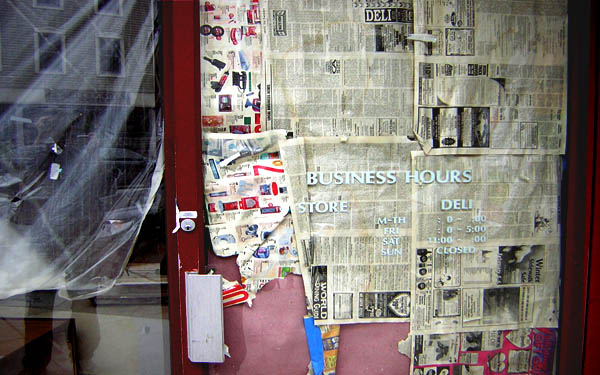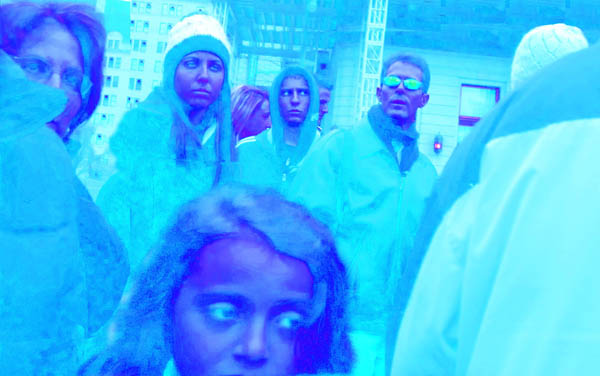Mon 15 Oct 2007
If it ain’t fixable, don’t break it . . .
One of the recurrent quotable quotes in the climate biz goes something like “if we act now, we can avoid the worst effects of global warming.” Well, I went to my files to find a recent example for you – but I almost couldn’t. With the accelerating change observed in the past few months, the invocation of such optimism seems to be waning.

I did run across one very odd instance, however, from the Associated Press on September 23rd: “Scientists Hopeful Despite Climate Signs” (1). Cheerily citing leading researchers like James Hansen and Michael Mann, we are told that “[C]limate scientists are sunny optimists. Hope blooms in the hottest of greenhouses.” To wit:
. . . mankind is on the path for soaring temperatures that will melt polar ice sheets, raise seas to dangerous levels, and trigger mass extinctions. But they say the most catastrophic of consequences can and will be avoided.
Or, as Stanford expert Stephen Schneider put it, “Sure a 2-degree [Centigrade] rise in temperatures is bad. But 4 or 5 degrees would be even worse.”
Strangely, such articles never (!) tell us what these worst case scenarios look like.
Worse and Worser
If you read actual reports from these same scientists, it’s pretty clear that such statements are so out of character that one must wonder just what manner of illegal substances were administered before the interviews (or perhaps it was just the author’s opium dreams). Be that as it may, it seems that melted polar ice sheets, dangerous sea levels and mass extinctions aren’t the “most catastrophic of consequences.” Just what, then, does “most catastrophic” mean?
Another article, which had appeared a scant four days earlier (“Too Late to Avoid Global Warming”), paints a rather starker picture (2). A two-degree rise, considered the threshold for catastrophic climate change, is virtually inevitable according to the Intergovernmental Panel on Climate Change (IPCC). As mentioned in previous Climate Chronicles posts, two degrees Centigrade is the minimum in the pipeline due to delayed effects of CO2 already out there, growing positive feedback loops, and arrant disregard by carbon spewing corporate governments hell-bent on economic expansion. Worse- and worst-case scenarios are increasingly likely.

What do these scenarios look like? To start with, “crop failures, water shortages, sea-level rises, species extinctions and increased disease” and “millions of people at risk from drought, hunger, flooding.” And the “IPCC assessment states that up to two billion people worldwide will face water shortages and up to 30 per cent of plant and animal species would be put at risk of extinction if the average rise in temperature stabilises at 1.5C to 2.5C.” And so far we have little reason to believe that the temperature will stabilize at an increase of 2.5C degrees.
“Rajendra Pachauri, chairman of the IPCC, said: ‘Wheat production in India is already in decline, for no other reason than climate change. Everyone thought we didn’t have to worry about Indian agriculture for several decades. Now we know it’s being affected now.’ There are signs a similar shift is under way in China, he added.'” (3)
Billions Die – for Starters
And there you have it (some of it, that is): Two billion or more of us will have precious little if anything to drink or eat. Consider that we’re around 300 million in the United States. The thirsty and starving outnumber us more than six to one. Put another way, if that ratio of ill- to well-being were to apply at home, six out of seven of your friends and neighbors would look like concentration-camp refugees en route to cadaverhood, watching you eat and drink while they shriveled and starved.
Of course, that’s not the way it works out. Those of us (at least the cozy middle and upper class of us) in first-world countries – while we munch our organic bananas, trip in our bio-fuel-fed hybrids and dream of squiggly lightbulbs – wring our hands over how the mostly more tropical third world, not to mention indigenous peoples of the Arctic Circle, will suffer the greatest consequences. The brunt of suffering, we are so sorry to hear, will fall to the former colonies of somebody or other. And that’s probably true – briefly. But as Ronald Wright points out in A Short History of Progress, “[W]ealth is no shield from chaos, as the surprise on each haughty face that rolled from the guillotine made clear” (4).
Will the real worst consequences please step forward?
If it’s not in your neighborhood already, catastrophic climate change will soon arrive in all of its fulminant glory. Aside from the “obvious” rising sea levels, hurricanes, droughts, etc. etc. (this list is getting so boring already), what might Terra Tostada look like by 2050, just to pick a currently popular, “safely” future, year? (5)

Given the astonishing acceleration of everything to date, and selecting a feasible temperature increase of 3C degrees (three times the current increase since the industrial revolution), here’s an unfortunately possible 2050 (perhaps earlier) picture:
As a result of (1) drooling oil companies and a rash of discoveries since the melting of the Arctic ice in its entirety, (2) the thousands of new coal plants put on line to fuel the third-world economic expansion through the year 2025, and (3) the positive feedback loops that released methane from tundras and deep ocean, atmospheric greenhouse gases (carbon dioxide and other heat-trapping gases) reached a horrific 700 parts per million (ppm), an increase of 250 ppm over the concentrations in the year 2007 (6), a level not seen for untold millions of years on planet Earth.
That makes it pretty warm where I live in New England, most of Boston is under water, the maple trees have picked up and moved to Canada, there’s no more skiing, little resembling winter, scorching summers, not much of an apple crop, but lots of mosquitos and new tropical diseases (7). And that’s the least of it.
No Food, No Water
Fresh water is rare, for drinking or farming. Food is hard to grow and harder to find. In human history that has always meant privation and war.
The great midwest breadbasket has pretty much dried up, as has the California fruitery. The world grain supply is far behind demand, let alone putting in a surplus, even with the loss of two billion lives from starvation, disease and the World Resource War of 2030. There are hundreds of thousands of deaths from disease and starvation every day (8).
Local food is increasingly difficult to grow just about everywhere as a result of unpredictable and violent weather. Florida is a spreading swamp and the people who are left (not the Bush family, which has settled in at its 400,000-acre ranch in Paraguay) are huddling on higher ground, constantly battling the annual thirty or so Category 5 hurricanes in a season that runs from March to November.
Now that the centralized resources for national governments have fallen apart, local crime and turf wars are common. New Orleans after Hurricane Katrina, or the endless conflicts in Baghdad after “mission accomplished,” or the chaos and rape in the current lawless Congo, are glimpses in 2007 of what that looks like. Many countries, including the United States, have become balkanized fiefdoms, and those with the mightiest weapons generally prevail (which is nothing new, of course). Dogs, formerly known as “pets” but now feral, are a constant threat; people collect themselves in fortified communities where the weather allows some semblance of agricultural stability. But mostly, human life lurches on in violently run dictatorships, and we’re all on our own, like street kids.

The prognosis is not good. Even with diminished population the prospect of habitats compatible with human life – and life of many other species – is rapidly vanishing. As populations migrate towards ever-decreasing acres of livable land, the overuse of resources accelerates and the environment is, once again, ruined.
Apocalypse Very Soon
If this sounds like yet another tale of apocalypse, it is. But this one isn’t science fiction. The first few chapters have already been written, if only we would read them. Can we do other than plunge through the storms to an inevitable and tragic final whimper? (9)
Yes, we can.
Next time: Not to leave you in the lurch, faithful reader, Climate Chronicles tells you a different truth about what we can do in the face of impending disaster – it’s certainly Beyond Inconvenient, and it’s neither easy nor fun (depending, of course, on what you consider easy and fun).
Copyright 2007 by Adam D. Sacks, all rights reserved.
1. “Scientists Hopeful Despite Climate Signs,” Seth Borenstein, The Associated Press, September 23, 2007, http://www.truthout.org/issues_06/092407ED.shtml. Here’s another example: “[R]ich countries should recognize a need for cuts of between 25 and 40 percent below 1990 levels by 2020 to avert the worst effects of climate change,” from “Rich Countries Deadlocked Over 2020 Climate Goals,” Reuters, August 30, 2007, http://www.truthout.org/issues_06/083107EB.shtml.
2. “‘Too Late to Avoid Global Warming,’ Say Scientists,” Cahal Milmo,The Independent UK, September 19, 2007, http://www.truthout.org/issues_06/091907EA.shtml.
3. “How climate change will affect the world,” David Adam, The Guardian, September 19, 2007,
http://www.guardian.co.uk/environment/2007/sep/19/climatechange.
4. Ronald Wright, A Short History of Progress, Carroll & Graf, NY, 2005, p. 131.
5. For some ideas, see “Top 100 Ways Global Warming Will Change Your Life,” by the Center for American Progress, September 29, 2007, http://www.alternet.org/story/63895/. Please note that the otherwise apocalyptic litany in this post represents my own speculations. While based on extensive reading, I can’t cite scientific chapter and verse for all of it. But I can say, with considerable confidence, that scientists have so underestimated just about everything to date that the picture I sketch is far too well within the realm of possibility.
6. “Scientist: Greenhouse Gas Levels Grave,” Associated Press, October 9, 2007, http://www.truthout.org/issues_06/101007ED.shtml. “‘What the [pending IPCC] report establishes is that the amount of greenhouse gas in the atmosphere is already above the threshold that can potentially cause dangerous climate change,’ [climate scientist Tim] Flannery told the broadcaster late Monday. ‘We are already at great risk of dangerous climate change, that’s what these figures say. It’s not next year or next decade, it’s now.'”
7. Frumhoff, P.C., J.J. McCarthy, J.M. Melillo, S.C. Moser, and D.J. Wuebbles. 2007. Confronting Climate Change in the U.S. Northeast:Science, Impacts, and Solutions. Synthesis report of the Northeast Climate Impacts Assessment (NECIA). Cambridge, MA: Union of Concerned Scientists (UCS), http://www.northeastclimateimpacts.org.
8. “Mother nature always comes to the rescue of a society stricken with the problems of overpopulation, and her ministrations are never gentle.” Alfred W. Crosby, Ecological Imperialism: The Biological Expansion of Europe, 900 – 1900, Cambridge University Press, 1986, p. 92.
9. One of my favorite climate catastrophe pieces is “Soylent Green,” a film made in 1973 (Edward G. Robinson’s final performance). We knew back then, we just pretended that we didn’t. The film is available on DVD.
One Response to “Terra Tostada – Life on Globally Warmed Earth”
Leave a Reply
You must be logged in to post a comment.
April 20th, 2010 at 9:54 pm
??????…. ???????… ? ?? ??????…
???????? If it ain’t fixable, don’t break it . . …..